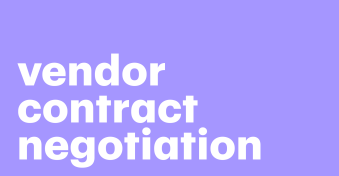Vendors keep your business running by providing critical services for day-to-day operations.
But to keep the quality of services up to par, you must employ a comprehensive vendor management strategy.
From vendor selection to continuous risk assessments, your business needs to establish a harmonious working relationship with vendors.
In this article, we’ll discuss vendor management best practices for managing your partnership with suppliers.
Key takeaways
- Vendor management involves nurturing and managing relationships with suppliers to maintain continuity, mitigate potential risks, and maximize revenue.
- Your business’s vendor relationship management strategy should focus on picking reputable service providers and establishing seamless communication channels with them.
- Add a supplier management solution to your stack to centralize data, improve reporting, and involve all authorized stakeholders in key business decision-making processes.
Properly vet every vendor beforehand
Before locking in a new vendor, thoroughly vet them to ensure they are the right financial and cultural fit.
First, you must check if they have a stellar reputation in the industry.
Then, confirm if they can guarantee stable, scalable service delivery across the supply chain.
You also have to check their public financial statements as part of the vendor management process.
If your vendor goes bankrupt, your business will take a massive hit in the crossfire.
Another evaluation criterion is compliance.
You depend on vendors who are up-to-date with compliance and regulatory standards.
This will help protect your privacy as well as avoid fines.
Other reasons to vet vendors include risk management, confirming a cultural fit, ensuring adherence to due diligence and ethical practices, aligning timelines, and choosing a suitable pricing model.
Establish clear, collaborative channels of communication
Vendor relationships don’t run on autopilot.
After the vendor onboarding process, ensure communication is a transparent, two-way street, and reach out regularly to maintain a collaborative ecosystem with them.
Effective vendor management involves sharing feedback about product performance or suggesting improvements in order to make adjustments.
Some companies add representatives to their Slack channel so employees can share urgent feedback and concerns with them.
You can also incorporate communication tools in SaaS applications and CRMs such as HubSpot and Zoho.
Be proactive in aligning business objectives
Having your business objectives aligned with chosen vendors is a must for a successful partnership.
Regularly review and discuss mutual goals, such as reducing costs or expanding market reach.
Doing this periodically will help you stay aligned on timelines, clear expectations, risk factors, and upcoming changes.
Go further by sharing strategic plans and future projects, which empowers them to tailor their services to your growth trajectory.
This proactive approach mitigates misalignments, strengthens partnerships, enhances service delivery, and drives long-term success.
Hire the right people for your team
The success of supplier relationships depends on the people interfacing with them. That’s why you should have the right personnel on your team.
For instance, when working with a managed security services provider, you need people who are well-versed in security protocols and compliance.
Their experience in the field will help them determine what to look for and negotiate favorable service level agreements (SLAs) and contracts. They’ll also know the metrics to track.
Stay ahead of compliance and risk
Vendor-related risks are usually financial, administrative, or reputational.
Proactively addressing vulnerabilities requires a mitigation mechanism to monitor and minimize these risk factors.
It starts with hawkishly exploring and implementing compliance and regulatory standards.
In most cases, big-time vendors and service providers such as Google and Amazon have airtight compliance.
But in some cases, the outsourcing partner might not cover some industry-specific regulations. That’s why tracking vendor compliance is important for staying up-to-date with regulation changes and store scorecards.
Track your spending
Keep track of every dime you spend on outsourcing partners, vendors, and managed services providers. This will help your business optimize cost savings and maximize ROI.
Another aspect of vendor spending you must track is contract auto-renewals.
For services that are critical for business continuity, auto-renewals are usually an excellent option.

However, if the service is not essential or the vendor continues to adjust their service offerings, then deactivate auto-renewals.
Why? Because you want to make sure the new updates to the vendor’s services still align with your business goals and budget.
If your vendor wants to make pricing changes to the SLA, you must review the new contract.
For detailed, transparent accounting, use document management software to handle spending, payments, renewals, and upgrades.
This software will also help you set reminders and prevent duplicate transactions.
Double down on security
Your business strategy demands you keep all data safe and secure — and that includes seeking out a relationship with a like-minded strategic vendor.
After all, you’ll be sharing access to your business data, and that contractor may then provide access to your internal systems and processes to third-party vendors.
This has the potential to be a massive cybersecurity risk if not set up properly.
One of the most notable victims of vendor risk was Equifax.1
A breach of their vendor, Apache Struts, compromised the data of over 147 million consumers, resulting in a $1.38 billion loss.
A breach in the MyFitnessPal app tanked Under Armour2 shares by 4%.
While all cases aren’t that costly, data breaches are common across industries within the vendor ecosystem.
With that in mind, you have to beef up your data security when working with vendors. Start by conducting audits and assessments on their security infrastructure and encryption protocols (MFA, tokenization, role-based access controls, pseudonymization, zero-trust architecture).
You also have to agree on safe data storage and transfer policies with the vendor — and ensure they adhere to them throughout the contract lifecycle.
In addition, consider adding an automated real-time detection and response mechanism to your systems.
This will give you a head start on implementing preventive measures to mitigate risks if a breach occurs.
Document and optimize your vendor management flow
The path from procurement and vendor sourcing to termination should follow a systematic approach within your company.
This involves creating a playbook to document how to negotiate contracts as well as the roles and responsibilities of stakeholders.
Some aspects of vendor management that you can optimize for performance and user satisfaction include:
- Contract negotiation and signing
- Vendor performance tracking
- Contract renewal or upgrade
- Request for proposal (RFP) and invoice processing
- Compliance monitoring
- Dashboard reporting
- Notifications
Done right, automation will enhance your workflows by reducing the time taken to close deals with the right vendors while guaranteeing the accuracy of records and communications.
Use the right tools
Using vendor management software will help you maintain your relationships and track performance.
Here are some tools for managing vendors:
- Communication tools
- Compliance monitoring tools
- Analytical tools
- ERP and CRM integrations
- ESignature solutions
- Contract management software
With a tool that combines all these features, you’ll simultaneously prevent the formation of data silos as well as improve your vendor partnerships.
Evaluate vendor performance
Successful vendor management involves monitoring contract performance to see if they are delivering on their end of the deal.
Focus on the impact of their services on your bottom line. To get accurate data, use real-time analytical tools and include dashboards to centralize the view for all stakeholders.
Always measure the ROI and deliverables of the services they provide to determine whether to ditch them or renew the contract.
The contract terms should outline the key performance indicators (KPIs) and metrics. Some of them include delivery speed, service uptime or downtime, satisfaction score, and churn rate.
Have a clean exit strategy
Your relationship with your vendor can end for several reasons. You might be looking for better alternatives, they might be going through financial troubles, or you just don’t require their services again.
Without a clear-cut exit strategy, you will end up trying to escape the tentacles of problematic vendors lacking financial stability, especially when they are deeply embedded in your business operations.
So what gives?
Your contract with key vendors should expressly declare the conditions for cancellation, termination, or suspension.
Before you leave, ensure that you give them a notice within the established window, usually within 30 to 90 days. They also need to hand over all your data, documentation, inventory records, and intellectual property.
If you abandon the contract without following due process, you might end up paying fines or damages.
Manage vendor relationships using PandaDoc
As we mentioned above, one of the most important vendor management best practices is to choose the right contract management tools.
PandaDoc delivers a document management system for vendors that contains multiple contract templates that you can customize to your specific business scenario. You can also use it to draft, redline, negotiate, and share important folders with suppliers.
The platform also provides a legally binding eSignature solution that you can use to speed up negotiations, including useful features like embeddable fields and fillable forms.
Start a free trial and find out how PandaDoc can help you manage vendor contracts.
Disclaimer
PandaDoc is not a law firm, or a substitute for an attorney or law firm. This page is not intended to and does not provide legal advice. Should you have legal questions on the validity of e-signatures or digital signatures and the enforceability thereof, please consult with an attorney or law firm. Use of PandaDoc services are governed by our Terms of Use and Privacy Policy.


